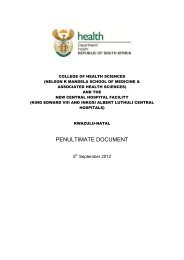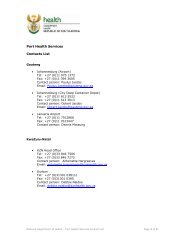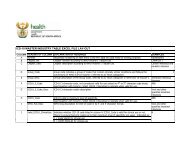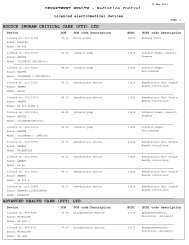National Norms and Standards relating to Environmental Health
National Norms and Standards relating to Environmental Health
National Norms and Standards relating to Environmental Health
Create successful ePaper yourself
Turn your PDF publications into a flip-book with our unique Google optimized e-Paper software.
• Vacant l<strong>and</strong>;• Office accommodation;• Any other premises as per the definition in terms of the <strong>National</strong> <strong>Health</strong> Act 61 of 2003.NORMS AND STANDARDS APPLICABLE TO ALL PREMISESThe following norms <strong>and</strong> st<strong>and</strong>ards are applicable <strong>to</strong> all premises:1. Building structure must be in compliance with the requirements of the <strong>National</strong> Building Act, the<strong>National</strong> Building Regulations, 103 of 1977, <strong>and</strong> well as the SANS 10400: Application of the <strong>National</strong>Building Regulations.2. <strong>Health</strong> education should form an integral part of all environmental health compliance inspections.Water Supplya) The quality of water supply must comply with the SANS 241 for drinking water, with regards <strong>to</strong>microbiological, chemical <strong>and</strong> physical quality.b) Potable running water must be continually available on all premises for drinking, preparing foodstuffs<strong>and</strong> <strong>to</strong> accommodate all uses in the day care center.c) Where the premises are not equipped with running water, a minimum of at least 10-25 liters perperson per day must be kept <strong>and</strong> s<strong>to</strong>red hygienically on the premises.Sewage <strong>and</strong> drainage systemsd) Drinking water must be adequately s<strong>to</strong>red <strong>and</strong> protected against contamination.e) Suitable <strong>and</strong> effective means of drainage <strong>and</strong> sewage disposal must be provided on all premises, incompliance <strong>to</strong> the Part-P of the <strong>National</strong> Building Regulations <strong>and</strong> SANS 10400.f) Water must be s<strong>to</strong>red at a temperature of at least 60 0 c <strong>and</strong> distributed at 50 o c minimum, <strong>to</strong> preventthe risks of ligionella.Waste managementa) Approved methods of waste collection, s<strong>to</strong>rage, transportation <strong>and</strong> disposal must be adopted.b) The collection, s<strong>to</strong>rage <strong>and</strong> disposal of general waste, must be managed in accordance with therequirements as specified in Part U of the <strong>National</strong> Building Regulations <strong>and</strong> Section 2-5 of the <strong>Norms</strong><strong>and</strong> St<strong>and</strong>ards for Waste Management;c) An approved refuse area must be provided on the premises for the s<strong>to</strong>rage of all refuse pendingremoval;d) Access <strong>to</strong> waste s<strong>to</strong>rage facility must be limited <strong>to</strong> employees who have been trained with respect <strong>to</strong>the operation of a waste facility;e) An adequate number of refuse bins must be provided for the s<strong>to</strong>rage of general waste on thepremises.<strong>Health</strong> care risk waste managementa) The collection, s<strong>to</strong>rage <strong>and</strong> disposal of waste, including health care risk waste must be managed inaccordance with the requirements as specified in the SANS Code 10248 <strong>and</strong> Section 9-10 of the<strong>Norms</strong> <strong>and</strong> St<strong>and</strong>ards for Waste Management in this document.b) An adequate number of purpose-manufactured, leak-proof, sealable containers must be available forthe s<strong>to</strong>rage of health care risk waste. Such containers <strong>to</strong> be designed as <strong>to</strong> not allow the exposure ofneedles, cuts <strong>and</strong> other substances that may cause harm <strong>to</strong> service users or staff members;c) Containers used for the s<strong>to</strong>rage of health care risk waste must be clearly labeled in large, legiblelettering;d) Employees must be adequately trained in the identification, separation, h<strong>and</strong>ling <strong>and</strong> s<strong>to</strong>ring of healthcare risk waste;e) Containers used for the s<strong>to</strong>rage of health care risk waste must be clearly labeled in large, legiblelettering;f) Employees must be adequately trained in the identification, separation, h<strong>and</strong>ling <strong>and</strong> s<strong>to</strong>ring of healthcare risk waste;g) <strong>Health</strong> care risk waste may only be removed/ collected, transported, treated <strong>and</strong> disposed by aregistered service provider from the premises.DOH. <strong>Norms</strong> <strong>and</strong> st<strong>and</strong>ards for environmental health in South Africa Feb 2013 14



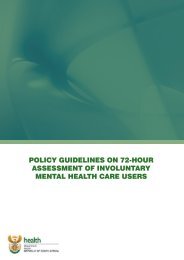
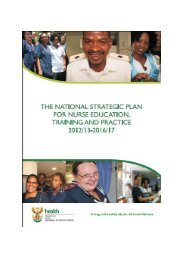
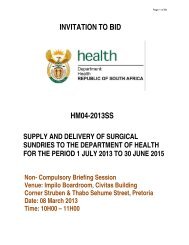
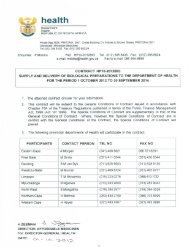
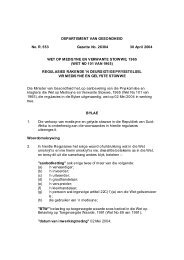
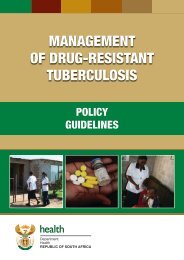
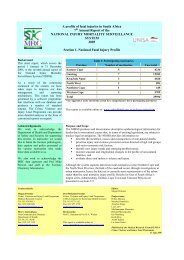
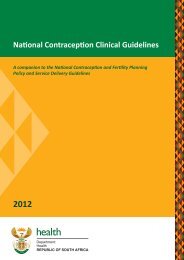
![A monograph of the management of postpartum haemorrhage [2011]](https://img.yumpu.com/15578784/1/184x260/a-monograph-of-the-management-of-postpartum-haemorrhage-2011.jpg?quality=85)
